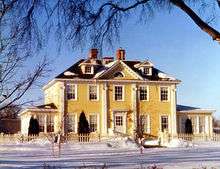Longfellow House
Coordinates: 44°54′58″N 93°12′51″W / 44.916149°N 93.214134°W
| Longfellow House | |
|---|---|
|
The Longfellow House from the Parkway. | |
| Former names | Henry Wadsworth Longfellow House |
| General information | |
| Type | House |
| Architectural style | Colonial |
| Location | Minneapolis, Minnesota |
| Current tenants | Park Board Interpretive Center |
| Construction started | 1906 |
| Completed | 1907 |
| Owner | Minneapolis Park Board |
| Technical details | |
| Floor count | 3 |
| Design and construction | |
| Architect | Robert "Fish" Jones |
The Longfellow House in Minneapolis, Minnesota, United States, is a 2/3 scale replica of Henry Wadsworth Longfellow's home in Cambridge, Massachusetts.[1] Built in 1907, the house was neither seen or lived in by Longfellow (who died in 1882), but was the home of an admiring Minneapolis businessman named Robert "Fish" Jones.[2] Longfellow House stands within Minnehaha Park and is a contributing property to the Minnehaha Park Historic District.[3]
Early history
In 1885, Robert "Fish" Jones sold his downtown Minneapolis fish market, and built a zoo on the site where the Basilica of St. Mary stands today. He eventually moved his zoo a few miles south into an area next to the Minnehaha Creek. He rebuilt his zoo, the Longfellow Zoological Gardens, and opened it in 1907. At the same time, he built a house for himself, styled after Henry Wadsworth Longfellow's home. A yellow frame house with porches at each end,[4] he lived there for the next 23 years until he closed the zoo, due to complaints from nearby residents. He agreed to give the house to the City of Minneapolis, but died in 1930 before the transaction was completed.[1]
Longfellow Community Library
For four years after Jones' death, the house remained vacant, following which the Park Board was deeded the house, offering it to the Minneapolis Public Library. The library purchased it for $1,500, $500 of which was raised by neighbourhood residents.[1] The Works Progress Administration converted the house into the Longfellow Community Library, which opened in 1937.[5]
The library performed well, serving the south easternmost portion of Minneapolis until the 1950s, when the growing prevalence of television cut circulation numbers at the library in half.[1] The demographic that fell the most during that time was not children, but adults. The library overcame this circulation drop, so much so that in 1967 the Library Board authorized the construction of a new library in the nearby Wenonah neighborhood. In 1968, Longfellow closed and Nokomis Community Library opened, instantly doubling Longfellow's circulation numbers.
The House today

The House fell into disrepair. During the early 1980s, it was used by the Saint Paul Jaycees as "Ghost Manor", a haunted house attraction every year at Halloween. In 1994, the expansion of Hiawatha Avenue was underway, the House was moved to its current location. In a partnership with the Minnesota Department of Transportation, the house was moved across the highway by Ernst Movers of Osseo, Minnesota and thus reconnected with Minnehaha Park which the house had been separated from.[6] It was then renovated by the Kodet Architectural Group.[2][7] The moving process won the Department of Transportation an honorable mention by the Federal Highway Administration in the historic preservation category.[6] In 2001, the house opened as an interpretive information center, run by the Park Board.[2][7]
References
- 1 2 3 4 Benidt, Bruce Weir (1984). The Library Book: Centennial History of the Minneapolis Public Library. Minneapolis: Minneapolis Public Library and Information Center. ISBN 0-9613716-0-9.
- 1 2 3 "Mississippi National River and Recreation Area - Longfellow House Hospitality Center (U.S. National Park Service)". National Park Service. 2006-07-27. Retrieved 2008-04-17.
- ↑ Grossman, John (1969-10-22). "National Register of Historic Places Inventory – Nomination Form: Minnehaha Park Historic District" (PDF). National Park Service. Retrieved 2015-05-05.
- ↑ Jones, Robert (1927). Longfellow Gardens. Minneapolis.
- ↑ "Architecture". Longfellow House–Washington's Headquarters National Historic Site. 2004. Retrieved 2008-04-17.
- 1 2 "2002 Excellence in Highway Design Awards". Federal Highway Administration. 2003-04-28. Retrieved 2008-12-10.
- 1 2 Kirby, Jennifer (2008-03-14). "The Longfellow House". Retrieved 2008-12-10.
External links
- Longfellow House at Placeography.
- Longfellow House at the Hennepin County Library.
- Longfellow House at the Minnesota Historical Society.